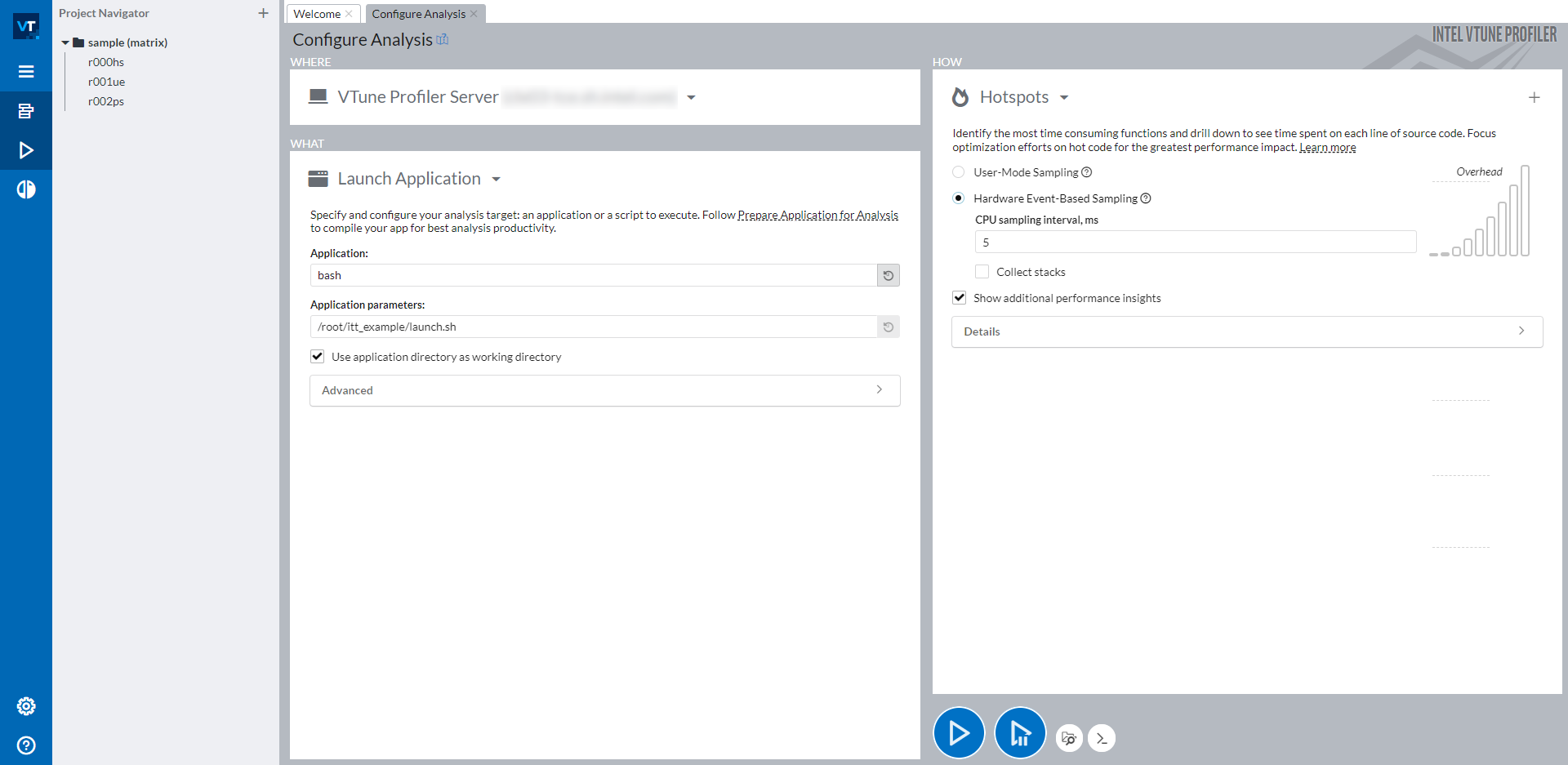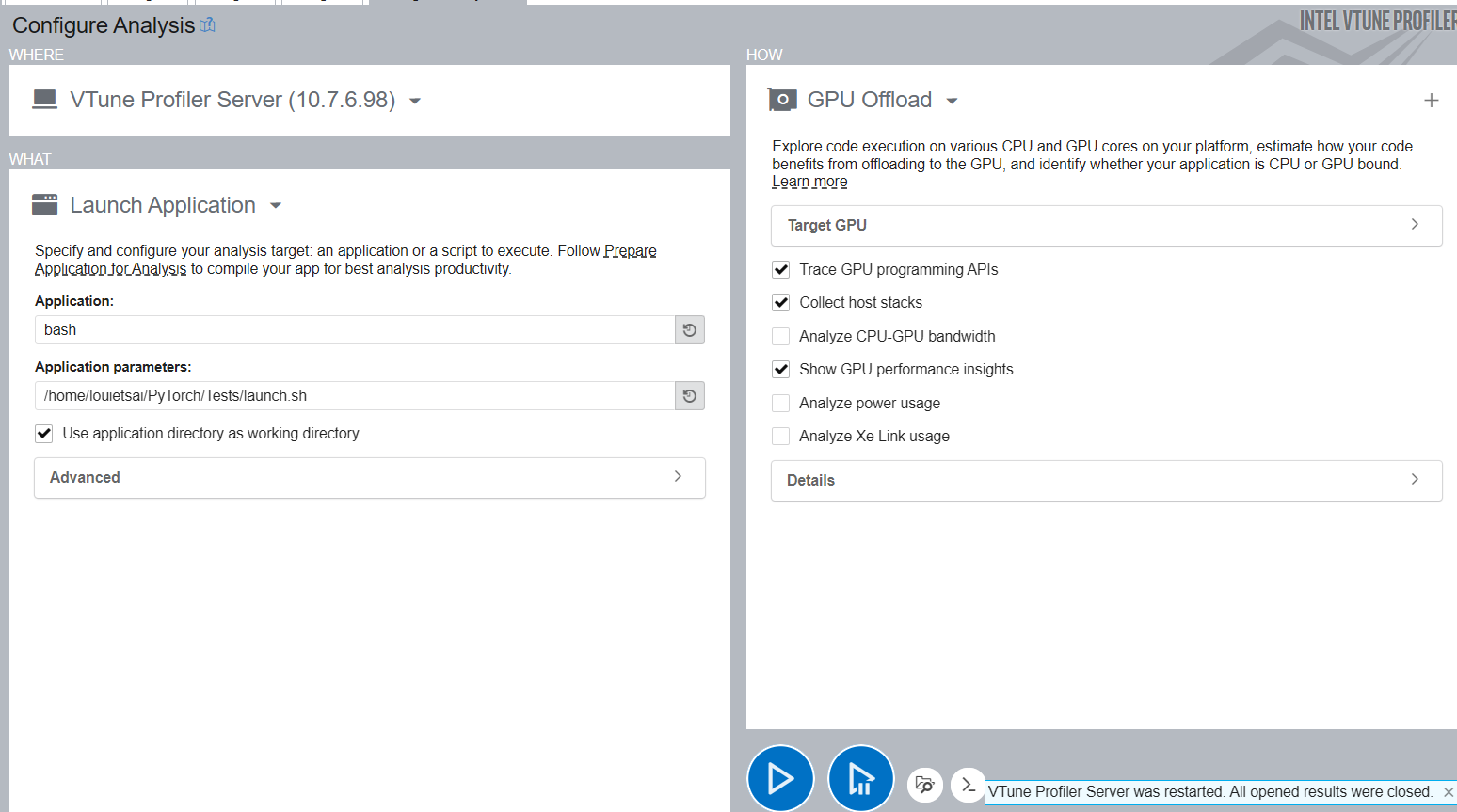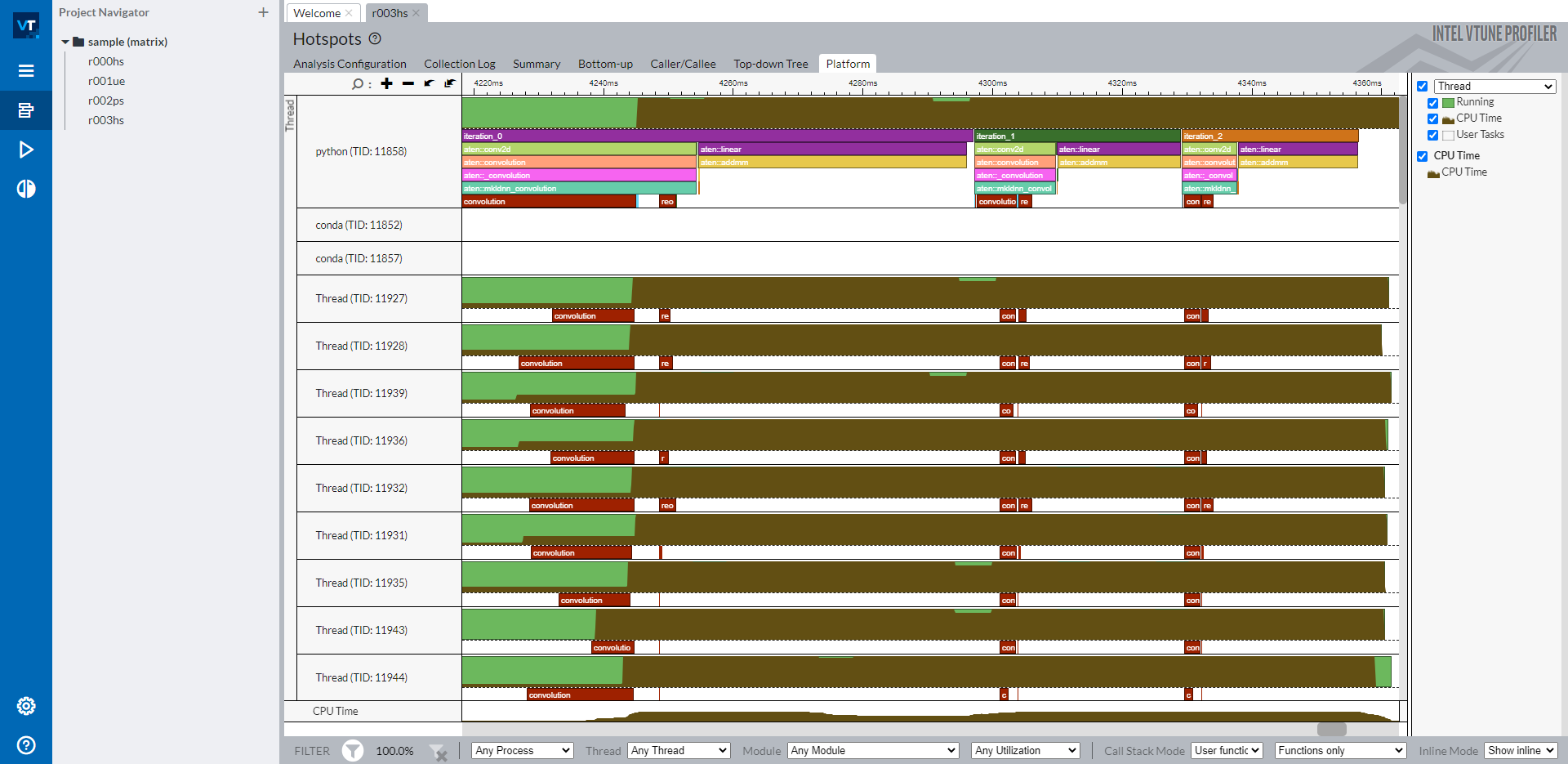使用 Instrumentation and Tracing Technology (ITT) API 对 PyTorch 工作负载进行性能分析¶
创建日期:2022 年 10 月 27 日 | 最后更新日期:2024 年 10 月 24 日 | 最后验证:未验证
在本范例中,你将学习
什么是 Intel® VTune™ Profiler
什么是 Instrumentation and Tracing Technology (ITT) API
如何在 Intel® VTune™ Profiler 中可视化 PyTorch 模型层级
一段简短的示例代码,展示如何使用 PyTorch ITT API
什么是 Intel® VTune™ Profiler¶
Intel® VTune™ Profiler 是一款用于串行和多线程应用程序的性能分析工具。对于熟悉 Intel 架构的用户,Intel® VTune™ Profiler 提供了一套丰富的指标,帮助用户了解应用程序如何在 Intel 平台上执行,从而对性能瓶颈有所了解。
包括入门指南在内的更多详细信息可在 Intel 网站上获取。
什么是 Instrumentation and Tracing Technology (ITT) API¶
Intel® VTune™ Profiler 提供的 Instrumentation and Tracing Technology API (ITT API) 使目标应用程序能够在执行期间生成和控制跟踪数据的收集。
ITT 功能的优势在于能够在 Intel® VTune™ Profiler GUI 上标记单个 PyTorch 算子以及自定义区域的时间跨度。当用户发现任何异常时,这有助于定位是哪个算子出现了意外行为。
注意
ITT API 已自 PyTorch 1.13 版本起集成到 PyTorch 中。用户无需调用原始的 ITT C/C++ API,只需调用 PyTorch 中的 Python API 即可。更多详细信息可在 PyTorch 文档中找到。
如何在 Intel® VTune™ Profiler 中可视化 PyTorch 模型层级¶
PyTorch 中提供了两种使用方式:
隐式调用:默认情况下,所有遵循 PyTorch 算子注册机制注册的算子在启用 ITT 功能后会自动被标记。
显式调用:如果需要自定义标记,用户可以明确使用 PyTorch 文档中提到的 API 来标记所需的范围。
要启用显式调用,期望被标记的代码应在 torch.autograd.profiler.emit_itt() 范围内调用。例如
with torch.autograd.profiler.emit_itt():
<code-to-be-profiled...>
启动 Intel® VTune™ Profiler¶
要验证此功能,你需要启动一个 Intel® VTune™ Profiler 实例。请查阅 Intel® VTune™ Profiler 用户指南以了解启动 Intel® VTune™ Profiler 的步骤。
注意
用户也可以按照 Intel® VTune™ Profiler Web Server UI 指南使用 Web 服务器 UI,例如:vtune-backend –web-port=8080 –allow-remote-access –enable-server-profiling
启动 Intel® VTune™ Profiler GUI 后,应看到如下所示的用户界面:
左侧导航栏的 sample (matrix) 项目下有三个示例结果。如果你不想让性能分析结果出现在这个默认的示例项目中,可以通过蓝色 Configure Analysis… 按钮下的 New Project… 按钮创建一个新项目。要开始新的性能分析,点击蓝色的 Configure Analysis… 按钮启动性能分析配置。
配置 CPU 性能分析¶
点击 Configure Analysis… 按钮后,应看到如下所示的屏幕:
窗口的右侧分为 3 个部分:WHERE(左上)、WHAT(左下)和 HOW(右侧)。使用 WHERE,可以指定要运行性能分析的机器。使用 WHAT,可以设置要分析的应用程序路径。要分析 PyTorch 脚本,建议将所有手动步骤,包括激活 Python 环境和设置必要的环境变量,都封装到一个 bash 脚本中,然后分析这个 bash 脚本。在上面的截图中,我们将所有步骤封装到了 launch.sh bash 脚本中,并分析了 bash,参数为 <path_of_launch.sh>。右侧的 HOW,可以选择任何你想进行的性能分析类型。Intel® VTune™ Profiler 提供了多种性能分析类型供你选择。详细信息可在 Intel® VTune™ Profiler 用户指南中找到。
读取性能分析结果¶
成功使用 ITT 进行性能分析后,可以打开性能分析结果的 Platform 选项卡,在 Intel® VTune™ Profiler 时间轴中查看标签。
时间轴顶部显示主线程为 python 线程,下方显示各个 OpenMP 线程。标记的 PyTorch 算子和自定义区域显示在主线程行中。所有以 aten:: 开头的算子都是由 PyTorch 中的 ITT 功能隐式标记的算子。iteration_N 标签是使用特定 API torch.profiler.itt.range_push()、torch.profiler.itt.range_pop() 或 torch.profiler.itt.range() 范围显式标记的。详细信息请查阅下一节的示例代码。
注意
标有 convolution 和 reorder 的红色框来自 Intel® oneAPI Deep Neural Network Library (oneDNN) 的标记。
如右侧导航栏所示,时间轴行中的棕色部分显示了各个线程的 CPU 使用情况。在某个时间戳上,棕色部分占据线程行高度的百分比与该时间戳上该线程的 CPU 使用率相对应。因此,从这个时间轴可以直观地了解以下内容:
每个线程的 CPU 核利用率如何。
所有线程的 CPU 核利用是否均衡。所有线程的 CPU 使用率是否都很好?
OpenMP 线程的同步情况如何。OpenMP 线程启动或结束时是否存在抖动。
当然,Intel® VTune™ Profiler 提供了更丰富的性能分析功能集,可以帮助你理解性能问题。当你理解了性能问题的根本原因,就可以解决它。更多详细的使用说明可在 Intel® VTune™ Profiler 用户指南中找到。
读取 XPU 性能分析结果¶
成功使用 ITT 进行性能分析后,可以打开性能分析结果的 Platform 选项卡,在 Intel® VTune™ Profiler 时间轴中查看标签。
时间轴顶部显示主线程为 python 线程。标记的 PyTorch 算子和自定义区域显示在主线程行中。所有以 aten:: 开头的算子都是由 PyTorch 中的 ITT 功能隐式标记的算子。时间轴还显示了顶部的 GPU 计算队列,用户可以看到不同的 XPU Kernel 被分派到 GPU 队列中。
一段简短的示例代码,展示如何使用 PyTorch ITT API¶
下面的示例代码是上面截图中用于性能分析的脚本。
该拓扑由两个算子构成,Conv2d 和 Linear。执行了三次推理迭代。每次迭代都使用 PyTorch ITT API 以文本字符串 iteration_N 进行标记。使用一对 torch.profile.itt.range_push 和 torch.profile.itt.range_pop 或使用 torch.profile.itt.range 范围都可以实现自定义标记功能。
# sample.py
import torch
import torch.nn as nn
class ITTSample(nn.Module):
def __init__(self):
super(ITTSample, self).__init__()
self.conv = nn.Conv2d(3, 5, 3)
self.linear = nn.Linear(292820, 1000)
def forward(self, x):
x = self.conv(x)
x = x.view(x.shape[0], -1)
x = self.linear(x)
return x
def main():
m = ITTSample
# unmark below code for XPU
# m = m.to("xpu")
x = torch.rand(10, 3, 244, 244)
# unmark below code for XPU
# x = x.to("xpu")
with torch.autograd.profiler.emit_itt():
for i in range(3)
# Labeling a region with pair of range_push and range_pop
#torch.profiler.itt.range_push(f'iteration_{i}')
#m(x)
#torch.profiler.itt.range_pop()
# Labeling a region with range scope
with torch.profiler.itt.range(f'iteration_{i}'):
m(x)
if __name__ == '__main__':
main()
下面显示了在 Intel® VTune™ Profiler GUI 截图中提到的、用于封装所有手动步骤的 launch.sh bash 脚本。
# launch.sh
#!/bin/bash
# Retrieve the directory path where the path contains both the sample.py and launch.sh so that this bash script can be invoked from any directory
BASEFOLDER=$( cd -- "$( dirname -- "${BASH_SOURCE[0]}" )" &> /dev/null && pwd )
<Activate a Python environment>
cd ${BASEFOLDER}
python sample.py








